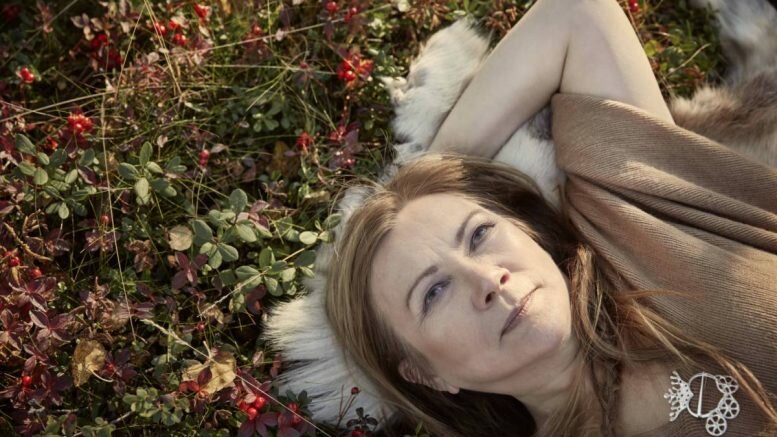Mari Boine gives us insights into her music, her life, the Sámi people, and more.
Though she grew up speaking Sámi, Mari Boine‘s parents were Christian and rejected traditional Sámi music – it was considered “the work of the devil.”
Boine re-discovered the depth of her ancestral heritage, including millennia-old musical traditions, as an adolescent in the 1980s.
She channeled her frustration at the oppression of her people, and awe at their culture, into music.
Since then, Mari Boine has brought her songs, a hauntingly beautiful blend of joik, jazz, folk, and more, to international audiences and created 15 albums that have inspired listeners around the world.
Mari Boine
Mari Boine is a woman of many sobriquets: from professional titles such as “the Sámi artist” across activist monikers like “the Sámi cultural ambassador” to more personal appellations such as “friend” and “mother.”
But how does Boine describe herself?
“I am an artist,
one who carries the old songs,
the old wisdom,
and one who carries the torch given by the ancestors
with the flame that should never go out.”
Sámi-eana
Boine currently lives in a house overlooking the Porsanger Fjord, which sits about 150 kilometers from the North Cape, and not far from her birthplace of Karasjok.
Modern-day nations have their own name for the Sámi community’s ancestral lands, but Boine tells us the Sámi name for the area:
“The name of our lands is Sámi-eana,
which means,
‘The land or the earth of the Sámi people.'”
Across Sámi-eana, so high north, nature is rugged, it is cold, and life can be difficult… But this terrain is one of the world’s most beautiful and pristine.
Sámi communities were once more vastly dispersed, in all directions, but they were largely pushed to the north by the lands’ newer inhabitants over the years.
For sustenance, Sámi communities have traditionally relied on reindeer herding, living in tandem with the terrain, and the animals that thrive on it. This, naturally, shows in traditional Sámi cuisine.
What is Boine’s favorite Sámi food?
“My favorite Sámi meal is smoked reindeer meat and a dish made of blood and intestines, a meat soup with marrow.
Everything has to come from the reindeer.
This has been traditional food for generations.”
The use of each part of an animal points to the practice of not wasting any food, making the most out of it, and in doing so, ultimately, respecting nature. This is how the people of Sámi-eana have lived for centuries.
So, is Sámi-eana where Boine feels most at peace, most creative?
“Where I feel most at peace and most creative can change.
Sometimes it’s in my home close to the nature in Porsanger and other times in a town like Tromsø.
It’s also together with musicians I feel connected with; even in a big city, I can reach my creativity.
You can stay close to nature AND close to the nature in people.”
Sámi people
For hundreds of years, the Sámi people have been oppressed, persecuted, and displaced.
Their shamanistic religion was banned, with Christianity being pushed instead, their languages outlawed, their culture suppressed, their lands taken.
When did Boine learn about these struggles?
“I definitely didn’t learn about the Sámi struggle at home; my parents were too loyal to the Christians for that.
I first learned about it at the gymnasium and during my studies at the teacher training college in Alta.”
What does Boine think about ongoing oppression against the Sámi people?
“Things are better in Norway, but in Sweden, Finland, and Russia, it is still very bad.
In Norway, there is still too little respect for the Sámi rights to the land.”
Nonetheless, the Sámi people have accomplished much since the beginning of their struggles.
Today, there is a Sámi Parliament, a Sámi flag, and Sámi figures such as Mari Boine that are internationally acclaimed.
Indigenous communities
Boine believes there are still further steps to be taken, however, in terms of indigenous struggles.
“There is an ongoing struggle for all indigenous people all over the world, which will be there for years.
The good thing is that we as people are stronger and feel less inferior.
We have cleaned out the poison that colonization leaves in people.
My dream is that everywhere in the world people can respect each other for who they are.
Each other’s culture, language, religion, sexual orientation…
And that we manage to take care of Mother Earth together, without poisoning her and exhausting her as we are doing now.”
Mari Boine has worked with other indigenous artists, including Native American poet John Trudell, whose poetry is featured in two songs on Boine’s 2017 album See the Woman.
Boine has pointed out that indigenous peoples worldwide have a special spiritual connection to nature.
“I have found a lot of common expressions in John Trudell‘s and Jo Harjo‘s and Moana Maniapoto‘s poetry.
My hope and my dream is first and foremost that we, the indigenous people of the world who were given this wisdom as a heritage from our ancestors, manage to preserve and take care of our spiritual connection to nature, and that we manage to communicate this spirituality to the rest of the world.
I think this is the only way of stopping materialism and the destruction and pollution of the nature.
The big question is how indigenous peoples and minorities can preserve their cultures in an increasingly globalized world.
Alone, we definitely cannot!
Only if the rest of the world understands what a gift to us all our heritages are.
And we need to heal ourselves from the traumas of the colonization and stop believing the lies the oppressors filled us with.
We need to reconnect to the old wisdom of our ancestors.”
Music
The emotions elicited by the struggles of her people are reflected in Boine’s moving songs.
Why did Boine choose music, specifically, as her creative outlet?
“I think I would say I had no choice, to be honest.
The music chose me.
I write first for myself, then for everybody else who is open for it.
And often, I write to honor my ancestors.”
Using the phrase “devil’s music” seems to be a common theme for great music; such as blues, jazz, rock, and Sámi music, all of which seemed to shake up existing systems of power. Such phenomena can often be labeled as ‘impure’ in efforts to demean them.
For the Sámi people, Christianity in particular played a part in branding their music as such; as “the work of the devil.”
Boine, growing up with Christian parents and later finding a powerful connection to her ancestral Sámi culture, has ties to both worlds.
So, does religion, be it Christianity or ancient Sámi religion, play any part in Boine’s music?
“Both religions have been and are a great inspiration.
There has also been a great deal of anger…
But today, these two parts in me are at peace with each other.”
What is Boine’s answer to anyone who has said Sámi music is “the devil’s work”?
“I wish for you to overcome your fears and really open your heart to this wonderful medicine that our music is!
And let it heal you and strengthen your Spirit.”
Today, Boine draws on all of her diverse musical heritages, from Christian Lestadian hymns and Sámi joik chants to Norwegian folk music, also finding inspiration in genres like jazz, rock, and pop.
Boine masterfully intertwines these diverse musical influences into her songs.
Who are Boine’s favorite musical artists, from any genre?
“Earlier: Buffy Sainte Marie, Patti Smith, Billie Holiday, Janis Joplin, Elton John, Jan Garbarek.
For the time being: Emilie Nicholas, Olafur Arnalds, Slin Craze, Kajsa Balto.”
Does Boine have any songs that are extra close to her heart?
“I have many; it’s hard to choose one.
For the time being, they’re Olafur Arnalds‘ Tomorrow’s Song and Sara Ajnnak‘s Wake up Sleepwalker.”
Most of Boine’s albums have been in Sámi, but See the Woman, her most recent album, was all-English.
Does Boine plan to release new music in the future – in Sámi and/or English again?
“I’m currently working on a new album in Sámi, and the release will be next year.”
Bridging the gap
What would Boine recommend to people who wish to educate themselves on Sámi culture, history, and struggle?
“Visit Sámiland, but come with an open mind…
Get down from the high horse if you are from one of the privileged cultures of the world.
Read books about the subject. To start, I recommend Gabriel Kuhn‘s Liberating Sápmi.
Visit websites like this one. Watch movies about the subject.
Talk with different Sámi and indigenous people, listen to what they have to tell.
Listen to our music.
Really read the lyrics, and translations, of our songs.”
More information on Mari Boine, details on her music (plus song lyrics), and translations of her songs can be found on the official Mari Boine website here.
To conclude, enjoy a snippet from the song See the Woman, written by Native American poet John Trudell and performed by Mari Boine, from Boine’s album of the same name.
She survives all man has done
In some tribes she is free
In some religions
she is under man
In some societies
she’s worth what she consumes
In some nations
she is delicate strength
In some states
she is told she is weak
In some classes
she is property owned
In all instances
she is sister to earth
Source: Norway Today
Do you have a news tip for Norway Today? We want to hear it. Get in touch at [email protected]




Be the first to comment on "“The music chose me”: A talk with Sámi artist Mari Boine"